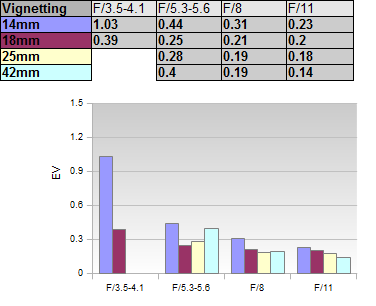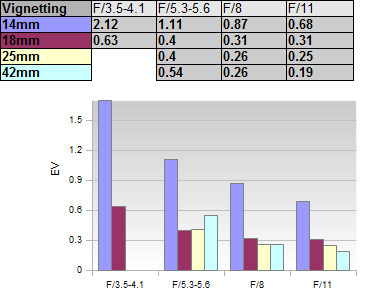|
Panasonic Lumix G 14-42mm f/3.5-5.6 ASPH OIS II - Review / Test Report - Analysis |
|
Lens Reviews -
(Micro-)Four-Thirds
|
|
Page 2 of 3

Distortion
Technically distortion is a bit of a weak spot on MFT lenses. The system relies on an auto-correction and as such minimizing the issue isn't really a priority. This is not relevant from a user perspective because the corrections are applied "under the hood". Thus standard JPEGs or conventionally converted RAW files don't show a significant amount of distortion (less than 1%).
However, it is still interesting to look a bit behind the scenes by using an "unsupported" RAW converter. This reveals a native barrel distortion of 4.8% at 14mm. This is hefty although its much more expensive in-house cousin, the Panasonic 12-35mm f/2.8 OIS, as well the directly competing Olympus M.Zuiko 14-42mm f/3.5-5.6 II R are actually still worse here. The distortion is still high at 18mm but eases beyond.
Vignetting
The (corrected) light fall-off is still high at 14mm @ f/3.5 (~1 f-stop) although a lesser issue at other settings.
 The uncorrected view is quite a bit worse again with a vignetting that exceeds 2 f-stops at the critical 14mm f/3.5 setting. Stopping down to f/8 resolves most of the issue albeit it remains visible. The other settings aren't quite as affected though.
The uncorrected view is quite a bit worse again with a vignetting that exceeds 2 f-stops at the critical 14mm f/3.5 setting. Stopping down to f/8 resolves most of the issue albeit it remains visible. The other settings aren't quite as affected though.

MTF (resolution)
The resolution characteristic of the 14-42mm f/3.5-5.6 ASPH OIS II is surprisingly impressive. The center quality is excellent (just) at large apertures in the lower range and very good from f/5.6 onward. The outer image region reaches good to very good levels. It is also positive that this behavior is very even across the range.
The strictly decreasing center performance along the aperture range may be surprising for some but remember that diffraction effects are actually starting to kick in fairly early on micro-four-thirds system. Unless other factors have a really significant impact the peak resolution is typically reached around f/2.8 and the Panasonic lens is obviously slower than that even at max. aperture.
The centering quality of the tested sample was just Okay.
Please note that the MTF results are not directly comparable across the different systems!
Below is a simplified summary of the formal findings. The chart shows line widths per picture height (LW/PH) which can be taken as a measure for sharpness.
If you want to know more about the MTF50 figures you may check out the corresponding Imatest Explanations
Chromatic Aberrations (CAs)
The lens produces a quite low amount of lateral CA (color shadows at hard contrast transitions) with an average pixel width of less than ~1px at the image borders fully open. The CAs decrease when stopping down and aren't really an issue at and beyond f/5.6.

|